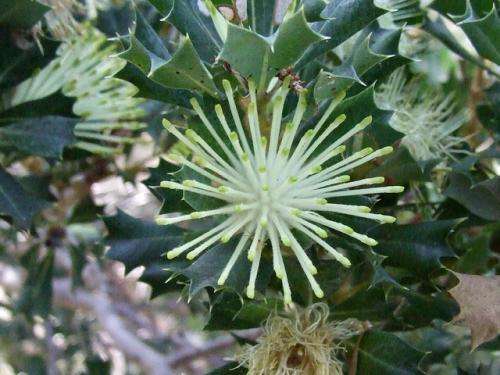Poor survival of proteaceous species such as parrot bush (Banksia sessilis) and honey bush (Hakea lissocarpha)—mixtures containing these individuals sequester less carbon.Image: Bill & Mark Bell
Local flora species involved in UWA's Ridgefield Multiple Ecosystem Services Experiment are helping researchers to better understand agricultural processes including efficient nutrient cycles and maintaining biodiversity.
Situated on the university's Ridgefield Farm near Pingelly, the experiment aims to highlight clean, green and ethical animal production; innovative cropping practices and how ecological restoration can be integrated to make for a more sustainable agricultural future.
UWA School of Plant Biology research associate Dr Michael Perring says Ridgefield is a field scale trial that aims to understand how the identity of woody plant species, and their combinations in different mixtures, influences the delivery of several ecosystem processes and attributes.
Researchers are also aiming to understand relationships among different services such as carbon sequestration, maintenance of biodiversity, more efficient nutrient cycles, prevention of soil erosion and resistance to non-native species.
"We're also looking at how relationships depend individually and in combination on the attributes of the nearly 12,000 individuals of eight species planted," Dr Perring says.
"In a nutshell, we're asking whether there are trade-offs or synergies among particular ecosystem services."
The network of experiments, which is involved in international tree diversity project TreeDivNet, is offering unique opportunities to coordinate knowledge transfer, in relation to forest policy and management from systems across the globe and investigating relationships between tree species diversity and ecosystem functioning.
"Most recently, our individual results on survival within the experiment are being used in an ongoing global analysis across all the experiments to try and understand whether species diversity provides an insurance for stable ecosystem functioning," Dr Perring says.
"It will be interesting to find out whether there are generalisable patterns from the different experiments, as this is then suggestive of rules that can be applied elsewhere."
Scientists are expecting significant results as the experiment matures over the next 10 years, but they are already seeing treatment effects and differences in survival among species.
Among the most significant results are:
- Greater growth in mixtures containing nitrogen-fixing species jam wattle (Acacia acuminata) and manna wattle (Acacia microbotrya), and an overall strong performance of the two main tree species York gum (Eucalyptus loxophleba ssp loxophleba) and brown mallet (Eucalyptus astringens).
- Poor survival of proteaceous species such as parrot bush (Banksia sessilis) and honey bush (Hakea lissocarpha)—mixtures containing these individuals sequester less carbon.
- Limited changes in nutrient dynamics and surface soil moisture among different plant mixtures but a strong influence of the herbaceous layer in influencing soil moisture and nutrient dynamics.
Provided by Science Network WA























